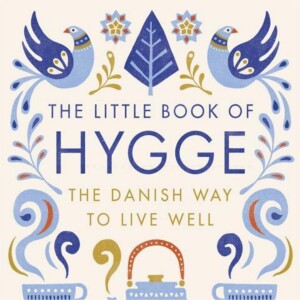
"The Little Book of Hygge: The Danish Way to Live Well" is authored by Meik Wiking, who is the CEO of the Happiness Research Institute in Copenhagen. The book was published in 2016 and aims to introduce readers around the world to the Danish concept of "hygge," which is a quality of coziness and comfortable conviviality that engenders a feeling of contentment or well-being.
Meik Wiking is a Danish author and researcher primarily focused on well-being and happiness studies. His work at the Happiness Institute involves analyzing the reasons behind life satisfaction and how different societal factors influence happiness. Wiking's expertise and interest in what makes people feel happy and content powerfully inform "The Little Book of Hygge."
Hygge, although it has always been a core part of Danish culture, began gaining international recognition as a lifestyle trend around the time of the book's publication. In Denmark, hygge is often associated with social togetherness, relaxation, indulgence, and an appreciation for the simple pleasures in life.
"The Little Book of Hygging" puts forward a variety of methods that can help in achieving this elusive quality of life, encompassing aspects such as lighting (with an emphasis on candles), the right clothing (comfortable and cozy), and spending time with loved ones in a pleasing environment that cultivates warmth and happiness. The book also examines how these practices contribute to the consistently high happiness rankings of Denmark in global surveys.
Moreover, Wiking explores how the elements of hygge can potentially be adapted to different personal and cultural contexts, making it relevant irrespective of geographic location. By doing so, he offers practical advice on creating hygge so it's accessible to anyone looking to elevate their everyday well-being.
In summary, "The Little Book of Hygge" offers insights into achieving personal contentment and happiness through the Danish custom of hygge, written by a noted expert in happiness research, making the book both an informative and practical guide. The book not only explores a cultural phenomenon but also serves as a how-to in cultivating what many Danes naturally weave into their daily life.
Chapter 2 Analysis of Main Characters and PlotIt is a guide to understanding the Danish concept of hygge (pronounced "hoo-ga"), which roughly translates to a sense of comfort, togetherness, and well-being.
Written by Meik Wiking, who is the CEO of the Happiness Research Institute in Copenhagen, the book delves into the reasons why Denmark is consistently ranked as one of the happiest countries in the world, and how hygge plays a significant role in that happiness.
The book breaks down the various elements that contribute to hygge, such as lighting (candles are a must), clothing (think comfy sweaters), and social interactions (enjoying time with loved ones). It provides practical tips on how readers can incorporate hygge into their own lives, including home decor, recipes, and activities.
Overall, the core content of "The Little Book of Hygge" focuses on enhancing one’s quality of life by embracing simplicity, warmth, and connection in everyday moments. There isn’t a storyline or characters, but rather advice and insights on living a balanced and cozy lifestyle.
Chapter 3 Theme Exploration and Analysis"The Little Book of Hygge: Danish Secrets to Happy Living" by Meik Wiking delves deeply into the concept of "hygge," a definitive element of Danish culture that encompasses a feeling of cozy contentment and well-being through enjoying the simple things in life. This book is a guide on understanding and achieving one's own version of hygge, exploring various components that contribute to this cherished Danish tradition. Here are some specific themes and topics the book explores:
- Definition of Hygge:
- At the heart of the book, Wiking attempts to pin down the elusive definition of hygge, which is not just a word but an atmosphere and an experience. It's typically described as the feeling of being cozy, relaxed, and safe. Wiking explores how hygge is ingrained in the Danish psyche and lifestyle.
- Elements Contributing to Hygge:
- Lighting: Lighting is one of the most essential elements in creating a hygge atmosphere. Danes prefer soft, warm lights, and candles are almost a must to create the right ambiance.
- Companionship: While hygge can be enjoyed alone, it is often associated with a feeling of camaraderie and comfort found in the company of close friends and family. Small gatherings in cozy settings epitomize hygge.
- Home Décor: Comfortable furniture, textiles like throw blankets and cushions, and a lack of clutter are all part of making a home hygge. Emphasis is placed on creating a space that feels safe, personal, and inviting.
- Food and Drink: Sharing a meal or having a hot beverage also constitutes hygge. The focus is on indulgence and comfort rather than extravagance, emphasizing warmth and satisfaction through simple pleasures.
- Hygge Throughout the Year:
- Wiking discusses how hygge is not confined to the cold, dark winter months but is a concept that can be embraced year-round. He provides tips on how to cultivate hygge through all seasons, adjusting activities, settings, and menus accordingly.
- Psychological and Social Aspects:
- The book delves into why hygge is believed to be a key contributor to Denmark’s high happiness rankings. It discusses the psychological comfort that comes from hygge practices, such as prioritizing life’s simple pleasures and valuing cozy togetherness.
- Hygge also embodies a sense of community and simplicity, pushing back against materialism and the fast pace of modern life.
- Cultural Significance and Export:
- Wiking explores how hygge is an integral part of Danish identity and how its principles have been adopted and adapted around the world. He offers insight into how other cultures can experience and benefit from incorporating more hygge into their lives.
- Practical Tips for Incorporating Hygge:
- The book is practical, offering readers tips on how to hygge, from choosing the right lighting and furniture to hosting a hygge evening with friends. Wiking provides advice that aims to help readers find their own path to everyday contentment through hygge.
- Personal and Societal Benefits:
- Beyond individual well-being, hygge has implications for broader societal health; Wiking touches on the balance it offers against the potential pressures of consumerist and digital culture.
Overall, "The Little Book of Hygge" not only educates its readers on a significant cultural phenomenon but also serves as a guide to cultivating personal contentment and social harmony. The book invites readers to slow down, appreciate simplicity, and foster environments and relationships that nurture a happier state of being.
Book https://www.bookey.app/book/the-little-book-of-hygge
Quotes https://www.bookey.app/quote-book/the-little-book-of-hygge
YouTube https://www.youtube.com/watch?v=OCrWl0E9ad4
Amazom https://www.amazon.com/Little-Book-Hygge-Danish-Secrets/dp/0062658808
Goodreads https://www.goodreads.com/book/show/30045683-the-little-book-of-hygge
More Episodes
 2024-03-18
2024-03-18
 14
14
 2024-03-17
2024-03-17
 11
11
 2024-03-17
2024-03-17
 11
11
 2024-03-14
2024-03-14
 12
12
 2024-03-12
2024-03-12
 9
9
 2024-03-11
2024-03-11
 12
12
Create your
podcast in
minutes
- Full-featured podcast site
- Unlimited storage and bandwidth
- Comprehensive podcast stats
- Distribute to Apple Podcasts, Spotify, and more
- Make money with your podcast
It is Free
- Privacy Policy
- Cookie Policy
- Terms of Use
- Consent Preferences
- Copyright © 2015-2024 Podbean.com






